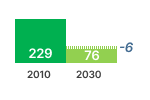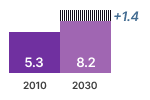Regulation 2019/1781 applies to 1-phase and 3-phase induction motors with powers from 0.12 to 1000 kW, including special purpose motors for explosive atmospheres, 8-pole motors and brake motors. In 2020 this regarded a stock of 380 million motors, consuming 1326 TWh/a of electricity. This is 56% of the final electricity consumption in EU27 in 2020 of 205 mtoe = 2384 TWh (Eurostat Energy Balance, Apr. 2023).
The previous Regulation 640/2009 applied to 3-phase motors with powers from 0.75 to 375 kWh, covering a stock of 88 million motors, consuming 903 TWh of electricity in 2020. Special purpose motors were not covered. The revised regulation 2019/1781 thus extends the scope by more than a factor 4 for the stock and a factor 1.5 for electricity consumption.
Source: estimations from the Ecodesign Impact Accounting Overview Report 2024
Scope
The following table shows some examples of products in scope and out of scope in the Ecodesign Regulation:
| In Scope | Out of Scope |
|---|---|
|
|
Check the complete list in the Ecodesign Regulation.
Ecodesign Requirements
All electric motors and variable speed drives (VSDs) in scope must meet the Ecodesign requirements when placed on the EU market. This is mainly a responsibility for manufacturers and importers.
The Regulation on electric motors and variable speed drives (EU) 2019/1781 entered into application as of 1 July 2021, replacing the Regulation on Ecodesign for electric motors (EC) 640/2009.
The energy efficiency of an electric motor is calculated as the ratio of the mechanical output power to the electrical input power. The energy efficiency level is expressed in International Energy efficiency classes (IE), IE1 being the lower class and IE5 the highest. Under the current regulation, motors must reach the IE2, IE3 or IE4 efficiency level depending on their rated power and other characteristics. For instance, three-phase motors with a rated output between 0.75kW and equal to or below 1000kW must reach the IE3 level by July 2021. Motors between 75kW and 200kW must meet the IE4 level as of July 2023. The EU is the first place worldwide making the IE4 level mandatory for some categories of motors.
Some motors designed for specific conditions are excluded from these rules, for example those that are immersed in a liquid such as in sewage systems.
The regulation also sets requirements the efficiency of variable speed drives. Variable speed drives have 2 levels of efficiency (IE1 and IE2) and the regulation requires all drives in scope to reach the IE2 level.
Both motors and drives are subject to information requirements, such as efficiency at different load points, in terms of speed and torque. This will help engineers to optimise the efficiency of entire systems.
Regulation (EU) 2019/1781 was amended in 2021 by the Commission Regulation (EU) 2021/341 that aims to clarify and improve some aspects of some of the Ecodesign regulations adopted in 2019.
International Cooperation
Electric motors represent around 50% of the global electricity consumption. Promoting market uptake of efficient motors and drives is an important contribution to the fight against climate change. The EU supports the Super-Efficient Equipment and Appliances Deployment (SEAD) Initiative bringing together countries across the world to cooperate in promoting efficient appliances. SEAD currently focuses particularly on electric motors, refrigeration, cooling and lighting and has set a goal of doubling the efficiency of these products sold globally by 2030, an ambition recently welcomed by G7 ministers. The new EU regulatory requirements entering into effect on 1 July contributes to this goal. The EU is also a member of the International Energy Agency 4E Electric Motors Systems Annex, which aims at raising worldwide awareness of the efficiency potential of motor systems and provides guidance and tools to exploit the energy performance of new and existing motor systems worldwide.
Highlights
A more efficient motor can generate savings ranging from a few euros to several tens of thousands euros over its lifetime, depending on its power and use pattern.
More efficient motors under the former regulation were expected to bring 46 TWh of annual energy savings in the EU by 2020. Taking into account the overall effect of the revised regulation, the annual savings will increase to 106 TWh by 2030, which is equivalent to the electricity consumption of the Netherlands. This means that 40 million tons of CO2 emissions per year will be avoided and that the annual energy bill of EU households and industry will be reduced by approximately €20 billion by 2030.
Besides, increased usage of variable speed drives in relevant applications, such as a pump delivering a water flow that changes with time, can generate considerable savings at the application level. This is encouraged by the regulation by requiring manufacturers of both motors and drives to provide relevant energy efficiency data at different speed/torque points, helping engineers to optimise the efficiency of motor systems.
Facts & Figures
This graphic shows the estimated sales, stock, energy consumption (primary, electric or fuel), greenhouse gas emissions, consumer expenses and business revenues for years 2010 and 2030. The estimated values inside the graph bars are those from the EIA ECO-scenario, they include the effects of Ecodesign and Energy Labelling measures.
The difference with the business as usual (BAU) scenario without these estimated measures is shown next to the graph bar. These figures indicate the estimated savings obtained due to the measures.
Product: Electric Motors and Variable Speed Drives Measures: Regulation (EU) 2019/1781 |
|---|
| The striped lines in the charts show the 'Effect of the Regulations' |
SALES (x1000 units)  | STOCK (x1000 units)  | Electricity (TWh/a)  |
GHG-EMISSION  | CONSUMER EXPENSES  | REVENUES  |
Source: estimations from the Ecodesign Impact Accounting Overview Report 2023
In 2020, 380 million electric motors in scope of the Ecodesign regulation were in use in the EU27, with powers between 0.12 and 1000 kW.
These motors produced a total mechanical output of 1177 TWh, enough to lift 42 million Eiffel Towers (10100 ton) by 1 km in height.
To do this, they used 1326 TWh of electricity, which is 53% of the total EU27 electricity consumption in 2020, and equivalent to 212 million electric cars driving around the world (40075 km at 6.4 km/kWh)
The 1177 TWh mechanical output and 1326 TWh electricity input in 2020 imply an average efficiency of motors in use of 88.8% . Without measures this would have been 88.0%.
In 1990, the same average was 85.7%. This means that motor energy losses decreased from 14.3% in 1990 to 11.2% in 2020 (-22%).
Due to Ecodesign, losses decreased from 12.0% to 11.2% in 2020: an improvement of 6.7%.
The sales-average efficiency of medium size 3-phase motors (0.75-375 kW) increased from 72.1 % in 1990 to 84.0% in 2020 (graph)

The regulations saved 52 TWh of electricity in 2020 (-3.7%), projected to increase to 107 TWh (-7.4%) by 2030.
The 2020 savings are 2.2% of the total EU27 electricity consumption in 2020, and higher than the consumption of Greece or Portugal in that year (48 TWh).
Due to Ecodesign measures, EU27 users saved € 3.8 billion (-2.2%) on motors in 2020, expected to increase to € 11 billion (-5.6%) in 2030.
Expected Savings
If no measures would have been taken since 2009, the electricity consumption of motors would have increased from 1192 TWh in 2010 to 1378 TWh in 2020 and 1449 TWh in 2030. Due to Regulation (EU) 2019/1781 this is reduced by 52 TWh in 2020 and 106 TWh in 2030. The latter savings represent 4.5% of the total EU27 electricity consumption in 2020.
Due to the previous motor Regulation 640/2009, the average efficiency of 0.75-375 kW AC 3-phase motors increased from 77.5% in 2009 to 82.1% in 2016. In parallel the share of motors sold with VSD increased from 17% in 2009 to 30% in 2016. Electricity savings due to Regulation 640/2009 were projected 46 TWh/a in 2020 and 92 TWh/a in 2030.
Consequently, compared to Regulation 640/2009, the revised Regulation (EU) 2019/1781 leads to 14 TWh/a additional savings in 2030.
ELECTRICITY, CONSUMPTION OF ALL MOTORS IN SCOPE OF Regulation (EU) 2019/1781


Electricity, Motors 3-Phase 0.75-375 KW in scope of (old) Regulation 640/2009


In 2030, considering 2.5 billion euros additional acquisition costs for higher efficiency motors and for VSDs, and 13.5 billion euros lower electricity costs, the net savings on total EU27 expenses for electric motors in scope of Regulation (EU) 2019/1781 are 11 billion euros.
Source: estimations from the Ecodesign Impact Accounting Overview Report 2024
Note about double counting: a share of the electric motors covered by the Regulation are incorporated in products covered by other Ecodesign Regulations (e.g. industrial fans). Therefore, a part of the energy consumption / savings sown here is also included in the figures of these other products, leading to a form of double counting. To remove the double-counting effect, the values shown here need to be multiplied by 0.55. Further explanations as well as figures without double counting are provided in the Ecodesign Impact Accounting Overview Report 2024.

Policy
Ongoing legislative work
Please check the ongoing initiatives on the Have your say portal.
Commission Regulation (EU) 2019/1781 of 1 October 2019 laying down Ecodesign requirements for electric motors and variable speed drives pursuant to Directive 2009/125/EC of the European Parliament and of the Council, amending Regulation (EC) No 641/2009 with regard to Ecodesign requirements for glandless standalone circulators and glandless circulators integrated in products and repealing Commission Regulation (EC) No 640/2009 (OJ L 272, 25.10.2019, p. 74–94).
Disclaimer: please pay attention to possible updates/changes as indicated in the Official Journal (green dot)

